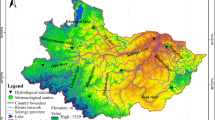Abstract.
Izmir Bird Paradise is one of the most valuable wetlands in Turkey, but this area is now being threatened by the drying out of marshes and water pollution. This wetland consists of two ecosystems: fresh- and saltwater. The recharge of marshes is from rainfall, the Gediz River and groundwater from Can Suyu Pond. The water type of the river is Ca–Mg–Na-HCO3–SO4, whereas the groundwater is a Na-Cl water type. The reasons for the drying are long-term drought (evapotranspiration at 894 mm is >> rainfall at 546 mm), and excessive pumping of groundwater and seawater intrusion into Menemen Plain. Therefore, an additional freshwater resource is necessary. This water can be supplied from the limestone levels of Neogene sedimentary rocks in and around Izmir Bird Paradise that have a Ca-HCO3 water type. Water pollution levels were also analysed. In the freshwater ecosystem Cd, Cr, Fe, Mn, Ni, Pb, Sb and Zn values, in the open channel in Izmir Bird Paradise Sb, Fe, Ni and Cd values, and in the river Fe, Pb and Sb values exceed the TSE 266 and EPA 2000 standards probably due to agricultural and industrial sources.
Similar content being viewed by others
Author information
Authors and Affiliations
Additional information
Electronic Publication
Rights and permissions
About this article
Cite this article
Somay, M.A., Filiz, S. Hydrology, hydrogeology and hydrochemistry of wetlands: a case study in Izmir Bird Paradise, Turkey. Env Geol 43, 825–835 (2003). https://doi.org/10.1007/s00254-002-0697-6
Received:
Accepted:
Issue Date:
DOI: https://doi.org/10.1007/s00254-002-0697-6




